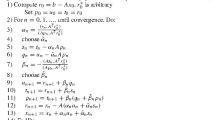Abstract
In this paper, based on the generalized global conjugate gradient squared (GGl-CGS) algorithm in Zhang et al. (Appl Math Comput 216:3694–3706, 2010) and the ideas in Gu et al. (Appl Math Comput 186:1243–1253, 2007), we present a parallel generalized Gl-CGS (PGGl-CGS) algorithm for linear systems with multiple right-hand sides. The new algorithm reduces two global synchronization points to one by changing the computation sequence in the generalized Gl-CGS algorithm, and all inner products per iteration are independent and communication time required for inner product can be overlapped with useful computation. Theoretical analysis and numerical experiments show that the PGGl-CGS method has better parallelism and scalability than the generalized Gl-CGS method, and the parallel performance can be improved by a factor of about 3/2.











Similar content being viewed by others
References
Bücker HM, Sauren M (1996) A parallel version of the quasi-minimal residual method based on coupled two-term recurrences. In: Proceedings of workshop on applied parallel computing in industrial problems and optimization (Para96). Technical University of Denmark, Springer, Lyngby
Chi LH, Liu J, Liu XP, Hu QF, Li XM (2005) An improved conjugate residual algorithm for large symmetric linear systems. In: Proceedings of the joint conference of ICCP6 and CCP2003 on computational physics, Rinton Press, New Jersey, pp 325–328
Freund RW, Nachtigal NM (1991) QMR: a quasi-minimal residual method for non-Hermitian linear systems. Numerische Mathematik 60:315–339
Freund RW (1997) A block-QMR algorithm for non-Hermitian linear systems with right-hand. Linear Algebra Appl 254:119–157
Grama A, Gupta A, Kumar V (1993) Isoefficiency function: a scalability metric for parallel algorithms and architectures. IEEE Parallel Distrib Technol 1(3):12–21
Gu TX, Liu XP, Mo ZY (2004) Multiple search direction conjugate gradient method I: methods and their propositions. Int J Comput Math 81(9):1133–1143
Gu TX, Zuo XY, Zhang LT, Zhang WQ, Sheng ZQ (2007) An improved bi-conjugate residual algorithm suitable for distributed parallel computing. Appl Math Comput 186:1243–1253
Jbilou K, Messaoudi A, Sadok H (1999) Global FOM and GMRES algorithms for matrix equations. Appl Numer Math 31:49–63
Jbilou K, Sadok H, Tinzefte A (2005) Oblique projection methods for linear systems with multiple right-hand sides. Electr Trans Numer Anal 20:119–138
Liu XP, Gu TX, Hang XD, Sheng ZQ (2006) A parallel version of QMRCGSTAB method for large linear systems in distributed parallel environments. Appl Math Comput 172(2):744–752
O’Leary D (1980) The block conjugate gradient algorithm and related methods. Linear Algebra Appl 29:3–322
Saad Y (1996) Iterative methods for sparse linear systems. PWS, Boston
Simoncini V, Gallopoulos E (1996) Convergence properties of block GMRES and matrix polynomials. Linear Algebra Appl 247:97–119
Sogabe T, Zhang SL (2003) Extended conjugate residual methods for solving nonsymmetric linear systems. In: Yuan Y-X (ed) Numerical linear algebra and optimization. Science Press, Beijing/New York, pp 88–99
Sonneveld P (1989) CGS: a fast lanczos-type solver for nonsymmetric linear systems. SIAM J Sci Stat Comput 10(1):36–52
de Sturler E, van der Vorst HA (1995) Reducing the effect of the global communication in GMRES(m) and CG on parallel distributed memory computers. Appl Numer Math 18:441–459
de Sturler E (1996) A performance model for Krylov subspace methods on mesh-based parallel computers. Parallel Comput 22:57–74
Vital B (1990) Etude de quelques de method de resolution de problemes liearies de grade taide sur multiprocesseur, Ph D Thesis, de Rennes, Rennes
van der Vorst HA (1992) Bi-CGSTAB: a fast and smoothly converging variant of bi-CG for the solution of nonsymmetric linear systems. SIAM J Sci Stat Comput 13:631–644
Yang TR, Brent RP (2002) The improved BiCGSTAB method for large and sparse nonsymmetric linear systems on parallel distributed memory architectures. In: 5th international conference on algorithms and architectures for parallel processing, IEEE Computer Society, pp 324–328
Yang TR, Lin HX (1997) The improved quasi-minimal residual method on massively distributed memory computers. In: Proceedings of the international conference on high performance computing and networking (HPCN-97)
Yang TR (2002) The improved CGS method for large and sparse linear systems on bulk synchronous parallel architectures. In:5th international conference on algorithms and architectures for parallel processing, IEEE Computer Society, pp 232–237
Yang TR, Brent RP (2003) The improved BiCG method for large and sparse linear systems on parallel distributed memory architectures. Inf J 6:349–360
Zhang JH, Dai H (2008) Global CGS algorithm for linear systems with multiple right-hand sides. Numerical Mathematics: A Journal of Chinese Universities 30:390–399 (in chinese)
Zhang JH (2006) New smoothing iterative block methods for linear systems with multiple right-hand sides. J Inf Comput Sci 1(5):311–317
Zhang LT, Huang TZ, Gu TX, Zuo XY (2008) An improved conjugate residual squared algorithm suitable for distributed parallel computing. Microelectr Comput 25(10):12–14
Zhang JH, Dai H, Zhao J (2010) Generalized global conjugate gradient squared algorithm. Appl Math Comput 216:326–329
Zhang LT, Zuo XY, Gu TX, Huang TZ (2010) Conjugate residual squared method and its improvement for non-symmetric linear systems. Int J Comput Math 87(7):1578–1590
Acknowledgments
The authors would like to thank the referees and Editor for their helpful and detailed suggestions for revising this manuscript.
Author information
Authors and Affiliations
Corresponding author
Additional information
Communicated by Ernesto G. Birgin.
This research of this author is supported by NSFC Tianyuan Mathematics Youth Fund (11226337), NSFC (61203179, 61202098, 61170309, 91130024 and 11171039), Aeronautical Science Foundation of China (2013ZD55006), Project of Youth Backbone Teachers of Colleges and Universities in Henan Province (2013GGJS-142), ZZIA Innovation team fund (2014TD02), Major project of development foundation of science and technology of CAEP (2012A0202008), Basic and Advanced Technological Research Project of of Henan Province (132300410373).
Rights and permissions
About this article
Cite this article
Zhang, LT., Zuo, XY., Gu, TX. et al. A parallel generalized global conjugate gradient squared algorithm for linear systems with multiple right-hand sides. Comp. Appl. Math. 34, 901–916 (2015). https://doi.org/10.1007/s40314-014-0158-3
Received:
Revised:
Accepted:
Published:
Issue Date:
DOI: https://doi.org/10.1007/s40314-014-0158-3
Keywords
- Sparse nonsymmetric linear systems
- Gl-CGS algorithm
- Krylov subspace methods
- Global communication
- Mutiple right-hand sides




